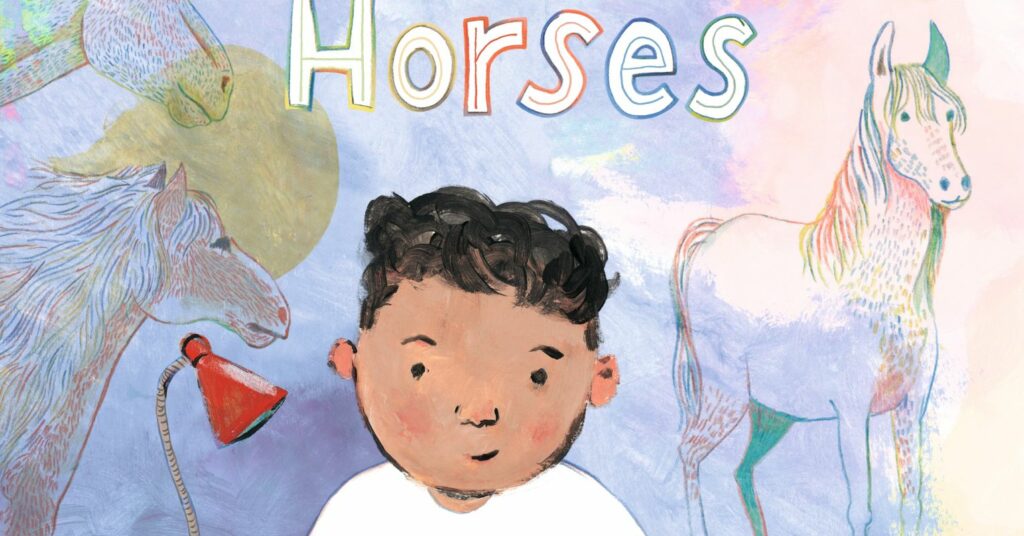Whether we realize it or not, our sibling relationships are often the longest relationships we have in our lives. However, sibling conflict is incredibly common and can even be detrimental to children as they grow up, possibly contributing to antisocial behavior, peer difficulties, sleep issues, and emotional and behavioral dysfunction (Bank L., et al, 2004, Dirks M. A., et al, 2015, Breitenstein R. S., et al, 2018).
While an authoritative parenting style and healthy family system overall can help to mitigate some of these effects, parents need to recognize that sibling conflict offers a valuable opportunity for children to practice social and emotional skills that will benefit them, both now and in the future (Liu C, Rahman MNA, 2022). Author Raymond Antrobus explores sibling conflict in his latest picture book, Terrible Horses, a touching story in which a little boy finds that drawing helps him to creatively work through his big feelings about his sister.
Raymond shared more about his book, and his own experience navigating sibling conflict in our discussion.
What inspired you to write a children’s book about sibling conflict? Do you have siblings, personally? If so, how has your relationship with your sibling unfolded over time?
I was thinking more broadly about conflict resolution and how it can be modeled to young readers. I’m a little brother to an older sister and I think of that as an identity. My sister and I had to overcome a lot of conflict between us as children to become closer to each other as adults as we used to fight all the time, just like the characters in the book. Like I said, we’re close now, but that relationship was something that needed intentional work.
Where do you see yourself in this story?
After live readings of Terrible Horses people have asked me if I see myself as a horse or a pony in the story. Often, I ask that question back and I hear people say, “Both, I have been persecuted and the perpetrator.” That’s all of us if we’re honest, no?
“Terrible Horses” explores sibling conflict and jealousy through a creative lens.
Source: Raymond Antrobus/Used with permission
Jealousy plays a role in the sibling conflict that takes place in the book. What do you think is the connection between jealousy and anger? Young children are quick to express jealousy, but adults grapple with this tricky emotion too, often quietly. How do the characters in your book overcome jealousy? Have you found ways to deal with jealousy in your own life?
Jealousy, personified as “the green-eyed monster” by Shakespeare, is a complex emotion because it’s hard to express it healthily. That’s where anger comes in as a follow-up feeling to jealousy. I try to be honest with my friends and family about when I feel jealous. For example, when my friend won a writing fellowship I really wanted (I also applied but got rejected), I told her “I’m so jealous of you, well done!” I acknowledged it rather than hide it and let it fester quiet resentment. It’s a feeling that affirms what one wants and hopefully, if we’re emotionally mature, we let it guide us toward our desires, rather than let it lead us astray into thoughts of comparison and deficiencies, which is how we feed our green-eyed monster! In the book, the jealousy between the siblings is soothed by an understanding that they are both struggling to be seen and understood. Realizing that about each other can keep that green-eyed monster away!
The little boy in your book finds a creative outlet for his anger. Through drawing and storytelling, he can express how he feels about his relationship with his sister, and process the conflict. Artistic expression is such a valuable tool for emotion regulation for children, and adults. How has creativity helped you manage your emotions, process experiences, or grow personally?
This is my forte. I studied creative writing and teaching with a focus on emotional literacy at Goldsmiths University. I conducted years of case studies working with young people in socially deprived areas, including my own hometown in East London. I saw firsthand how poetry can be an artistic and therapeutic tool for self-reflection and emotional healing as well as community building, and how it can affect projected academic achievement powerfully. For me, I always journaled and wrote about my emotional life, then used that as inspiration for poetry when I was as young as six and seven, even as my literacy was heavily lagging because of my undiagnosed deafness. I credit that intensely private practice of journaling and poem-making as a major factor in my eventual literary successes.
What do you hope young readers take away from spending time with your book? What about their parents or caregivers?
I hope every reader finds their own connection and resonance with the story, and that it encourages more generous perspectives of our personal and interpersonal conflicts. My son is almost 3 and when he reads it (he’s an only child) he just seems to love looking at the horses and their colorful intensities. Even that is enough for me. The illustrator Ken Wilson-Max did an excellent job. I’m jealous of his visual talent and I’m grateful that I got to work with him.
Source link : https://www.psychologytoday.com/za/blog/well-read/202410/how-to-resolve-sibling-conflict-creatively
Author :
Publish date : 2024-10-03 21:19:05
Copyright for syndicated content belongs to the linked Source.
